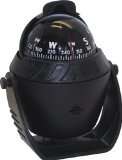Everybody knows what a compass is… that thing with a needle that points North – be it the Earth’s magnetic North Pole or one of the closest fridge magnets.

The best compass can vary in shape and size depending on its use; from tiny liquid-filled keyring models that are the size of a small button or high-end military instruments, compasses are indispensable to those who roam the mountains, deserts or high seas.
There are many variations: one can even build a working contraption floating a razor blade (remember those?) on water, on a leaf or a piece of styrofoam.
Contents
StansTips Savings For Compass [DEALs]
During manufacturing, razor blades are moved from one machine tool to the next with the help of electromagnets. This leaves a remanent field that is enough to rotate the floating blade and align it with the Earth’s magnetic field lines. The trick is to know which side points to which cardinal point in order to interpret the result!
Why floating?
The Earth’s magnetic field is encompassing (pun obviously intended) the whole planet, but it’s feeble. So the blade or needle must pivot around as frictionlessly as possible.

The blade must be in a horizontal position because field lines can be considered mostly parallel to the Earth’s surface (except near the poles, where the field lines tend to be vertical and navigation by these methods is very difficult). Both of these requirements are met by a can filled with water. Magnetite particles that constitute the magnetic sensor of homing pigeons are also floating in a liquid-filled cavity.
Even today’s marine and aircraft compasses usually have a liquid-filled enclosure which also plays the role of dampening the movements induced by the ship. “Dry” compasses are relying on gimbals to keep the needle level but in time their bearings can seize up.
Needles are usually replaced by a moving dial or ‘card’, that can display more information than a needle: east and west, as well as degrees from a certain mark on the bezel of the instrument.
There are of course, the digital compasses or – more accurately named – magnetometers. Using a set of four solid-state devices, aligned on the sides of a square, they measure the intensity of Earth’s magnetic field and show the bearing onscreen – be it a smartphone or a GPS.
The user is normally not aware of the innards of the device – it only cares to reproduce an analog instrument that he or she is familiar with. The advantages are clear: one can plot all the direction changes and easily find the way back even in uncharted territory.
You don’t have to keep your eyes on the display while moving; the device can signal any bearing change greater than a preset angle. The device can be programmed to ignore false signals – such as stray variable electromagnetic fields that might influence the sensors.
Regular satellite navigation devices do not have a magnetometer, but simply see the direction in which you are moving across the digital map and indicate the bearing accordingly. Such devices are not aware of the direction you are pointing to, unless you are moving. A compass or magnetometer can do that, of course.
The downsides
If you take a digital compass with you on a long hike, you have at least an extra worry: battery life; some devices are not well protected from water, so a simple rain can wreak havoc on your meticulously planned trip. You must complicate your life with spare batteries, solar panels, hand cranking chargers and waterproof bags with moisture absorbing sachets.
Big names in sports watches, like Suunto, Timex or Casio, have embedded digital compasses in some of their finest wristwatches. My personal favorites are from Casio’s Pro Trek line. Shock-resistant, solar-charged, precision compass (manual calibration is possible).
A military compass
If I could pick my ultimate compass, it would be a military or geological analog field compass.
Complete with an impact-resistant, waterproof case, scaled baseplate, tiny spirit level, tritium light-in-the-dark dial, or needlepoint, this would be the thing to depend upon a long expedition. No batteries or software glitches to worry about, just go along with the things Mother Earth offers for free, and feel like a dove flying home.